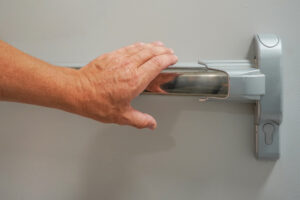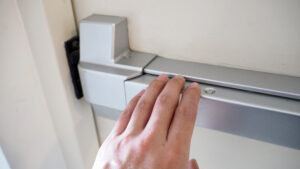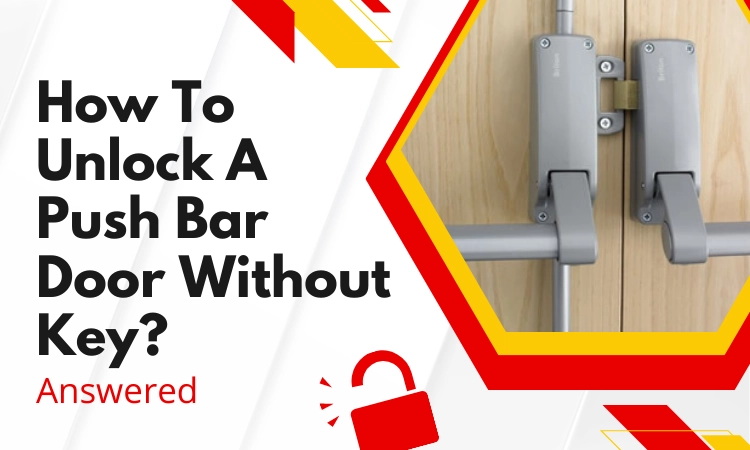Emergency exit doors are specially designed to make evacuation helpful. Most of the emergency push bar doors have a pain or crash bar connected to them.
If you’re seeing one for the first time you may wonder about the locking system. The last thing anyone could want is to wonder about how to unlock it during an emergency.
So, how to unlock a push bar door without key?
Emergency push bar doors don’t require any key to unlock them. Just pressing horizontally on the crash bar is enough to unlock it. You won’t need to put extra pressure on it to open it. Once you collide with the metal crash bar you’ll figure it out yourself.
That’s the sneak peek. Stay tuned to learn more, let’s begin!
How To Unlock An Emergency Push Bar Door?
An emergency push bar door can be unlocked by pushing horizontally on the crossbar or the push rail. The horizontal flat bar is attached to the inner surface of an outward-opening door.
It is designed in such a way that the user doesn’t require any prior knowledge to use them. It uses the latch mechanism that pulls back and unlocks the door.
Unlocking the push bar or panic bar door is quite simple. Classic push bars don’t even require an additional key. It is especially beneficial during an emergency situation.
But don’t confuse them with exterior fire-rated doors. Because the user doesn’t have to deal with a handle or a doorknob. Just bumping into the metal crash bar with little force is good enough to unlock the door.
There are many types of push bar doors with different locking and access control mechanisms. Some push bars are exit only and don’t contain any exterior device.
In some heavy commercial places, a dogging device is used on push bar doors. This device secures the release bar, allowing the push bar latch to remain retracted.
It allows the users to open the door from both sides. To use this feature you’ve to press the crash bar for the latch to retract. Then use a dogging hex key to latch the bar.
But this device is not meant to be used for fire exit emergency doors.
Other Types Of Push Bar Exit Doors & How To Unlock Them

There exists a variety of push bar doors with different locking mechanisms. Let’s take a look at these varieties!
Latch Mechanism:
This operates similarly to a conventional door latch. When you push down on the grip, the latch unlocks, opening the door.
These can be as simple as a single latch in the center point of the door. Or it could be heavily secured with three latches with ones at the top and bottom.
Bolt Mechanism:
In this mechanism, a long bolt runs up the side of the door. It secures both the top and bottom of the emergency exit door. When someone pushes the crash bar, the bolts are drawn in.
This causes the door to open. These bolts can be cut to appropriate sizes depending on the size of the door. Afterward, you can decide on the type of handle you want to use.
Touch Bar:
The touch bar mechanism is quite similar to the conventional push bar system. But the crash bar here works as a giant button rather than a crash bar that needs pushing.
So, when pressed, the door is released electronically rather than mechanically. It can work with both the bolt and latch mechanisms.
Push Pad:
The push pad mechanism is rather less noticeable across the door than a crash bar. Which makes it less suitable for use in public areas.
As they are less visible they should be used in places where people are well familiar with the layout. For example, storage facilities where only a selected few enters and are well familiar with the workspace.
External Latch:
The external latches are suited to fit any fire emergency exit doors regardless of the locking mechanism. So, you can gain access through any emergency or panic exit doors.
But security will be maintained as the exit door only unlocks from outside with a key. They come with a knob or a pull-down grip on the other side.
Problems With Push Bar Exit Device

When in an emergency it’s best if opening the exit door doesn’t need much effort. The push bar exit device does just that. It makes the exit door much more accessible.
As useful as these devices are, they can occasionally malfunction. Below are some issues that you might face with these devices.
Exit Device Installed Improperly:
Exit devices must be installed correctly for them to function properly. This is why it should be installed by experts in this field. Even if the installation is slightly improper, it can affect the door’s locking and unlocking mechanism.
Additionally, the crash bars need to be properly installed. Otherwise, it may not dislodge in times of emergency which can result in a catastrophic problem.
Not being careful with such devices can put people in danger.
Exit Device Got Stuck:
Panic bars or crash bars are fairly easy to clean. They are designed in a way that cleaning is not a mess. However, dirt and debris can yet accumulate in the cracks and crevices.
If there’s an excess of grime inside, it can prevent the bar from releasing when pressed inward. This causes the bar to become jammed in an open position.
When the fire alarm is making a whoop whoop noise you wouldn’t wanna get stuck with such a problem. To avoid issues like this, make sure you clean your panic exit bars on a regular basis
Exit Door Inhibited With Secondary Locks:
If you need to install secondary locks on your panic bar doors, take help froman expert locksmith. It is important that the locksmith recognizes how panic bars work and the standards that go with them.
When the panic bar is pressed, a lock installed incorrectly can prevent it from allowing access adequately. For example, if you have a bolt lock placed on the door, it may remain shut when pressed on.
So, it’s important that the installer knows which locking mechanism would be adequate.
General Regulation For Emergency Exit Doors
The type of locks that are applicable to emergency doors is governed by local building codes. Most building regulations prohibit installing additional locks on doors with an emergency exit device or push bar.
It also prohibits the use of a latch or chain on a door to lock it. Violation of these codes can lead to penalties and even imprisonment.
Here are some general regulations regarding the locking mechanism for emergency exit doors.
- Even in minimal environments, emergency exit door locks must open to the outside in a single motion. It shouldn’t involve twisting or pinching with the wrist.
- Egress locks are compliant with federal accessibility laws. They must be simple to open for children and people with limited mobility.
- The door hardware and locks must be installed at least 3 to 4 feet from the ground.
- The locks must not involve the use of any key, tool, special knowledge, or excess force to open.
The general rules for emergency doors will vary slightly depending on the egress type. There are two types of egress doors. One is controlled and the other is delayed type.
These automatic doors with fire safety are used in only a few selective places. They are rarely seen in public or commercial places.
Delayed Egress:
When someone pushes the panic bar of the delayed egress door, the hardware on it sets off a timer. After 15-30 seconds the lock gets released, allowing occupants to exit the passageway.
The general rules for delayed egress doors are included below.
- Delayed egress doors are not permitted in buildings used for education, assembly, or any high-risk activities.
- The locks should release immediately when the fire safety alarms are activated or the power is cut off.
- The locks on the doors must be fail-safe and the emergency exit light should stay on.
Controlled Egress:
Controlled egress is used in places where occupancies need to be permitted to go out. For example, places like psychiatric, nursing, detoxification, or memory care units.
They are not applicable in public places. If push bar egress doors are installed in such places the following rules are applicable.
- There could be only one controlled egress lock for a single door.
- The controlled egress doors must be accessible to facility staff at all times.
- The doors are set to automatically relock after releasing for egress.
- The locking system must be listed to UL-294 standards.
Frequently Asked Questions (FAQs):
What is the difference between a fire door and a fire exit door?
Fire doors are meant to block the spread of fire whereas fire exit doors are used for evacuation. Fire doors are installed on the interior walls but emergency exits are installed on the exterior wall. The signage of fire doors is blue & white whereas fire exit doors are green.
How does the emergency egress system work?
When a situation arises, the emergency egress locking mechanism automatically unlocks the emergency exit. For example, when a fire starts and the smoke detector triggers the egress system will automatically unlock all the egress doors.
Do fire doors need a key to unlock?
No, the fire protection doors don’t require any key. But it does need a special tool to unlock the door. It’s a special lock, such as a thumb-turn cylinder that unlocks the fire door from the inside. Unless you really need to open the door it’s better left unlocked.
Conclusion
Now you know how to unlock a push bar door without key. Well, even if you didn’t know, we’re sure you would have figured it out. Because push bar exit doors are that much reliable.
Don’t forget to abide by the guidelines if you’re to install one in your building.
Stay happy, stay safe!

